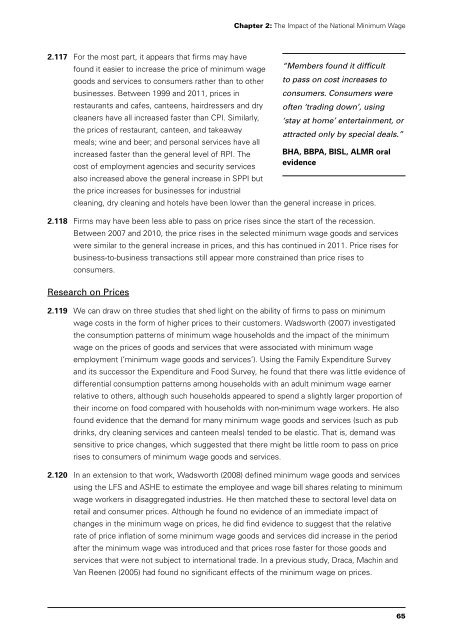National Minimum Wage
National Minimum Wage
National Minimum Wage
Create successful ePaper yourself
Turn your PDF publications into a flip-book with our unique Google optimized e-Paper software.
Chapter 2: The Impact of the <strong>National</strong> <strong>Minimum</strong> <strong>Wage</strong><br />
2.117 For the most part, it appears that firms may have<br />
found it easier to increase the price of minimum wage<br />
“Members found it difficult<br />
goods and services to consumers rather than to other to pass on cost increases to<br />
businesses. Between 1999 and 2011, prices in<br />
consumers. Consumers were<br />
restaurants and cafes, canteens, hairdressers and dry often ‘trading down’, using<br />
cleaners have all increased faster than CPI. Similarly, ‘stay at home’ entertainment, or<br />
the prices of restaurant, canteen, and takeaway<br />
meals; wine and beer; and personal services have all<br />
attracted only by special deals.”<br />
increased faster than the general level of RPI. The BHA, BBPA, BISL, ALMR oral<br />
cost of employment agencies and security services<br />
also increased above the general increase in SPPI but<br />
the price increases for businesses for industrial<br />
evidence<br />
cleaning, dry cleaning and hotels have been lower than the general increase in prices.<br />
2.118 Firms may have been less able to pass on price rises since the start of the recession.<br />
Between 2007 and 2010, the price rises in the selected minimum wage goods and services<br />
were similar to the general increase in prices, and this has continued in 2011. Price rises for<br />
business-to-business transactions still appear more constrained than price rises to<br />
consumers.<br />
Research on Prices<br />
2.119 We can draw on three studies that shed light on the ability of firms to pass on minimum<br />
wage costs in the form of higher prices to their customers. Wadsworth (2007) investigated<br />
the consumption patterns of minimum wage households and the impact of the minimum<br />
wage on the prices of goods and services that were associated with minimum wage<br />
employment (‘minimum wage goods and services’). Using the Family Expenditure Survey<br />
and its successor the Expenditure and Food Survey, he found that there was little evidence of<br />
differential consumption patterns among households with an adult minimum wage earner<br />
relative to others, although such households appeared to spend a slightly larger proportion of<br />
their income on food compared with households with non-minimum wage workers. He also<br />
found evidence that the demand for many minimum wage goods and services (such as pub<br />
drinks, dry cleaning services and canteen meals) tended to be elastic. That is, demand was<br />
sensitive to price changes, which suggested that there might be little room to pass on price<br />
rises to consumers of minimum wage goods and services.<br />
2.120 In an extension to that work, Wadsworth (2008) defined minimum wage goods and services<br />
using the LFS and ASHE to estimate the employee and wage bill shares relating to minimum<br />
wage workers in disaggregated industries. He then matched these to sectoral level data on<br />
retail and consumer prices. Although he found no evidence of an immediate impact of<br />
changes in the minimum wage on prices, he did find evidence to suggest that the relative<br />
rate of price inflation of some minimum wage goods and services did increase in the period<br />
after the minimum wage was introduced and that prices rose faster for those goods and<br />
services that were not subject to international trade. In a previous study, Draca, Machin and<br />
Van Reenen (2005) had found no significant effects of the minimum wage on prices.<br />
65


